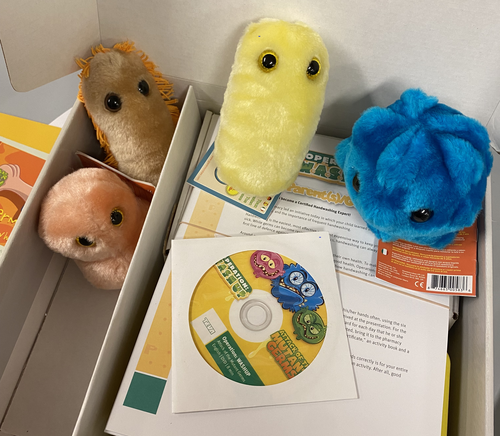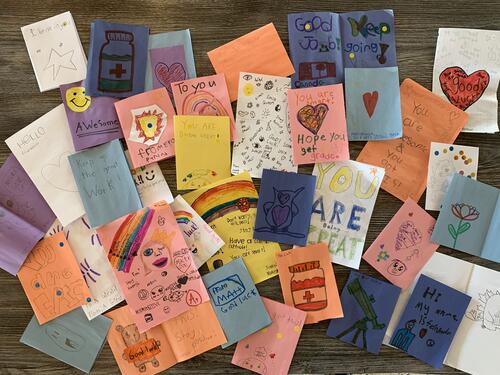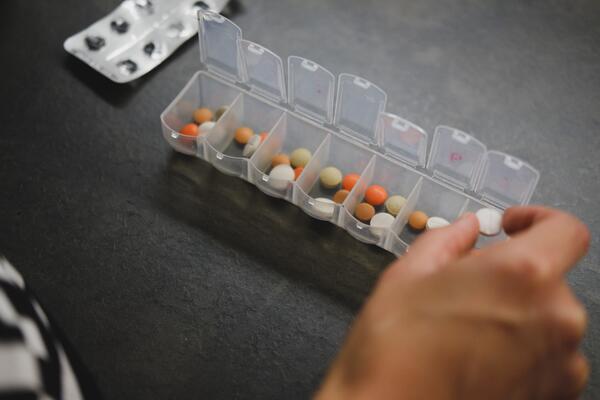
Inspiring the next generation of pharmacists
Waterloo School of Pharmacy students visit local elementary schools for Pharmacy Appreciation Month

Waterloo School of Pharmacy students visit local elementary schools for Pharmacy Appreciation Month
By Milana Madzarac School of PharmacyEvery March since 2016, students from Waterloo’s School of Pharmacy have been volunteering and visiting Region of Waterloo schools to educate the younger generation on what pharmacists do during Pharmacy Appreciation Month (PAM).
This year during PAM, 30 pharmacy students volunteered and presented to more than 400 elementary students across nine schools in the region.
Student volunteers Victoria Nguyen (PharmD ’25), Avery Brown (PharmD ’24) and Kia Moazzami (PharmD ’24) tailored each presentation to the specific grade level of the class they presented to.
The students are focused on imparting their knowledge of pharmacy and recognize this is an approachable way to interact with the children and educate them.

A kit including giant microbe plush toys and activity sheets designed by Waterloo Pharmacy students.
“We try to make the sessions as interactive and accessible as possible by using props and kits in our presentations to help children grasp the knowledge by interacting with the items,” says Brown. “Targeting everyone’s learning abilities through visual, auditory or kinesthetic learning is important to us.”
For younger children in kindergarten to grade two, the pharmacy students reviewed how even though antibiotics may not taste great, they do help them get better. The grades three to five presentations taught children about different types of allergies, how to spot reactions and how to administer epi-pens to someone in need.
“We hope that by teaching children the importance of pharmacy we are helping them make more informed choices in the future,” says Brown.
Pharmacy students also visited local high schools to share information about the pharmacy profession and the conditional acceptance to pharmacy (CAP) program to those who may not know it exists.
Sharing information about the program is a great avenue for high school students to learn about the opportunities available, especially for those who are ambitious and eager to get into the pharmacy field.

Thank you letters elementary school students made for Waterloo Pharmacy students who presented.
“I went through the CAP program myself and answering their questions is my way of inspiring them to dream about a future in pharmacy,” says Moazzami. “I’m able to share my own experiences and the path I took. We’re closer to their age, more familiar and approachable, which helps our interaction with them.”
While approaches for younger elementary students and high schoolers are different, both are an opportunity to share knowledge about pharmacy with the community.
In addition to providing education for the younger students, pharmacy students gain experience from these interactions. Through this volunteering opportunity, pharmacy students learn how to tailor their communication strategies to meet the needs of different populations.
“Hosting the school presentations is a great way to connect with our local community. We strive to advocate for the pharmacy profession, make health information more accessible and foster a safe and enjoyable environment for learning,” says Nguyen.
The Waterloo Pharmacy clubs involved in the elementary school visits include the Canadian Association of Pharmacy Students and Interns (CAPSI), Pharmacy Peer Relief Network (RxPRN) and the Paediatric Pharmacy Advocacy Group (PPAG).
March is Pharmacy Appreciation Month. This month, in the #PAM2023 series, the School of Pharmacy is celebrating the achievements of pharmacists and the future to come.

Read more
Waterloo School of Pharmacy co-op student invaluable to industry

Read more
Waterloo Pharmacy professor and doctoral student invited to discuss recent research findings in Neurology

Read more
Waterloo School of Pharmacy alum speaks to the benefits of the Minor Ailments Program
The University of Waterloo acknowledges that much of our work takes place on the traditional territory of the Neutral, Anishinaabeg, and Haudenosaunee peoples. Our main campus is situated on the Haldimand Tract, the land granted to the Six Nations that includes six miles on each side of the Grand River. Our active work toward reconciliation takes place across our campuses through research, learning, teaching, and community building, and is co-ordinated within the Office of Indigenous Relations.